THURSDAY, March 25, 2021 (American Heart Association News) — On nearly every corner, and along the roads in between, the familiar signs comfort and tempt us: burgers and fried chicken, ice cream and doughnuts, sweets and treats galore.
Welcome to the food swamp, where Americans get bogged down in a morass of cheap, convenient, alluring – and very often unhealthy – culinary choices.
“All these fast-food companies with all their marketing are competing for our stomach space and our dollars,” said Penny Kris-Etherton, distinguished professor of nutrition at Penn State University in University Park. “It’s hard to make healthy choices when there are so many odds against you.”
The term “food swamp” was coined about a decade ago to denote areas where fast-food chains and convenience stores abound, swamping healthier options such as grocery stores and restaurants with wider choices. They often coincide with food deserts, where a lack of convenient or low-cost supermarkets makes it harder to get fresh produce and nutritious food.
That combination all too often occurs in low-income and under-resourced neighborhoods, said Kristen Cooksey Stowers, an assistant professor at the University of Connecticut who specializes in health equity and food-related public policy.
“It’s not that fast food or corner stores are inherently bad,” she said. “But when it becomes the majority of what a neighborhood can rely on, that’s a problem. We see areas inundated with unhealthy food.”
Cooksey Stowers’ research has shown a correlation between food swamps and obesity, and she led a 2017 study published in the International Journal of Environmental Research and Public Health showing food swamps were a better predictor of obesity than food deserts.
Kris-Etherton was chief author of an article last year in the Journal of the American Heart Association linking food swamps and food deserts to poor diet quality, obesity and cardiovascular disease, all of which can be more prevalent among low-income people, many of whom are Black and Hispanic and other people of color. The authors called for policy changes to address the disparities.
In the long term, Cooksey Stowers said, solutions include better zoning to limit clusters of fast-food outlets, incentives to build grocery stores and farmers markets in disadvantaged areas, and even requiring convenience stores to stock a certain percentage of healthy food.
“People need to realize they are empowered to be part of the change in their communities,” she said.
In the meantime, if you’re hungry, keep this in mind:
Carry a healthy snack. An apple, carrot sticks or some nuts in the car might keep you from overdoing it at the drive-thru. “Take something with you so you don’t get really hungry,” Kris-Etherton said. “When you’re really hungry, you eat more.”
Be wary of bargains. “We’re all value-minded,” Kris-Etherton said. “You see supersizes, or buy one get one free. Maybe that makes sense if you’re with somebody, but not if you’re by yourself.”
Beware of beverages. Sugary sodas and coffee concoctions packed with flavors and cream can have more calories than an entrée. “People don’t think of it as something they’re eating,” she said. “They think, ‘It’s a drink. I don’t have to count it.’ They do.”
Pay attention to the extras. Mayonnaise on that burger or sub sandwich adds calories and fat. Ask for extra lettuce and tomato instead. So does the whipped cream stacked atop the coffee. “Doing without them is a small step, but a very good first step,” Kris-Etherton said.
So what if they’re open late? “There are brands trying to create the fourth meal of the day with all those late-night hours,” Cooksey Stowers said. “You know that’s terrible for the body. Stick with three meals a day.”
Make a plan and stick to it. “Check out the menu and choose healthy options, like salads and grilled chicken instead of fried,” Kris-Etherton said. “And if you can use the drive-thru, don’t go in, so you’re not tempted by seeing everybody eating burgers and fries with large sodas. Fries are OK on occasion but buy the small size or share an order with someone.”
Just say go. “If you can, keep driving or stay on that bus to get to the supermarket instead of stopping off for the fast food,” Cooksey Stowers said. “These are things that people know. We just have to eat less of the unhealthy stuff.”
American Heart Association News covers heart and brain health. Not all views expressed in this story reflect the official position of the American Heart Association. Copyright is owned or held by the American Heart Association, Inc., and all rights are reserved. If you have questions or comments about this story, please email editor@heart.org.
By Michael Precker
Copyright © 2025 HealthDay. All rights reserved.

